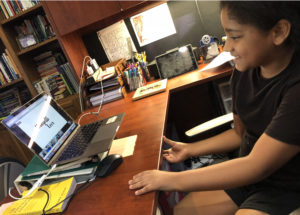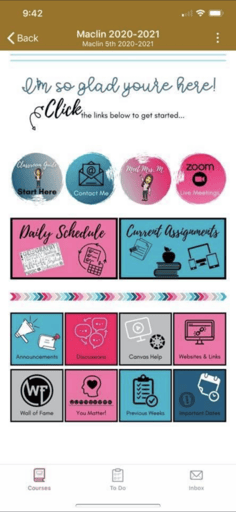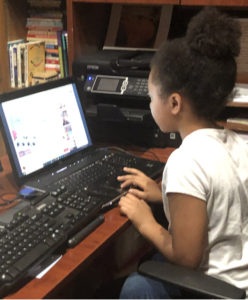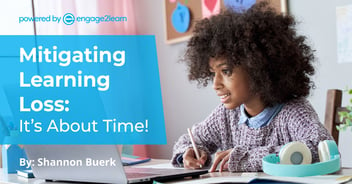8 Tips for Making Distance Learning More Personal for Learners
We all remember that teacher who made us feel special, helped us set goals and developed the grit and courage to meet them, made us believe in ourselves–even when we didn’t, inspired us to think in new ways, or lent a listening ear when we needed it the most. You liked your teacher, and your teacher liked you. There was a connection from the beginning, and that connection grew as the school year went on. As the great Rita Pierson, eloquently stated in her acclaimed TedTalk: “Kids don’t learn from people they don’t like.” Those kinds of teachers made a difference in our lives, and I bet it all started with two-way strong, authentic relationships.

Building relationships with students is at the very core of teaching. Indeed, teachers know the importance of seeing every child as a unique human being capable of infinite potential to learn and achieve success. Believing in each student’s potential is a precursor to building authentic and enduring connections, improving learning experiences, and increasing academic outcomes. When students feel connected and valued, they tend to work harder, get along better, and develop holistically.
Start with the Basics: Human Connections for ALL!
Amidst all the challenges we are facing this school year, you will still have to welcome, embrace and build relationships with students, not face-to-face as you have done so well in the past, but now via distance platforms.
Teaching during this pandemic will require a different type of teaching style, resources, strategies, and preparation. This school year will be different and certainly not business as usual. Humanizing the learning experience will require authentic connections, engagement, creativity, risk-taking, and innovation. More than anything else, it will require tons of growth mindset!

There are no magic formulas either. There are no experts. However, many great ideas, tools, and resources are surfacing on the internet, social-media, professional organizations, and books. So many indeed, it could be overwhelming!
So take it one step at a time! Start simple. Add to your instructional tool-kit as you and your students develop understanding and gain proficiency using new tools and platforms. The below pro tips can help you humanize and maximize your students’ distance learning experiences while also helping you navigate this ever-changing landscape with ease and confidence. You can do this!
- Reach out to every student personally. Undoubtedly, this will be a challenging endeavor, but now more than ever it is super-important to spend time at the beginning of the school year getting to know each of your students as individuals. In this effort, you will discover and experience each student’s uniqueness, culture, and personal story. Find out what excites them, what do they do for fun, what are they expecting from your class this year?, etc. Rita Pierson reminds us to never underestimate the “value and importance of human connections.” Start with relationship building and don’t forget to consider the importance of socio-emotional learning during a pandemic.
- Make that first interaction personal. Call each student on the phone or via Zoom, Google Meets, Skype, or other video teleconferencing platforms. It may take you 2-3 weeks to reach out to every student individually, but it will be worth it! Investing time to connect with your students before starting instruction will increase your ability to humanize the distance learning experience and will help you create enduring and authentic relationships with your students. Google Voice can help protect your phone number and your privacy.
- Manage interactions’ time, but be available. Decide beforehand how much time you are going to spend communicating with each student during that initial contact, and try your best to stick to that schedule. If there are special circumstances warranting additional time, provide opportunities for longer conversations. If a follow-up is necessary or requested, consider having a pre-established schedule with potential days/times to meet with students and parents.
- Create student profiles. Take notes during your interactions with each student. Create an easy to use database to safeguard each student’s profile. This information could be very useful later on as you continue building stronger connections with your students. Remember that managing digital data can be challenging if it is not organized well from the beginning. Therefore, create a system to organize all your data in order to avoid digital cluttering. Using Google Drive, which stores your files in the cloud, makes them accessible anywhere you are connected to the Internet. You can also make your files available off-line so that you can work on them at your convenience anywhere, and then when you connect to the internet, the off-line files you worked on will be automatically updated in the cloud.
- Get information from each student before making your initial contact. Before making your initial contact with each student, send them a Google form-survey or alike protocol requesting basic information, such as name, nickname, birthday, a goal they have for this school year, information about their pet, etc. Consider asking each student to upload a picture of themselves. Use Screencastify to provide simple step by step instructions on how to access, complete the survey, and upload their picture in writing and via video. Once you have collected information from all your students, you can select one of the games available in Flippity to facilitate your students’ relationship-building process. Here is a tutorial video on Flippity.
- “This is me: Your Student and Friend!” Encourage students to introduce themselves to you and their peers using video apps, memes, emojis, Tik-Tok, Flipgrid, etc. Make it fun. Encourage students to create and innovate by adding music and graphics. Provide parameters, expectations, and guidelines to ensure all students enjoy this activity and extend each other respect and professional ethics. After reviewing and approving each students’ submission, upload students’ videos into your LMS. Use these videos to build community. No doubt, these kinds of activities will help you build a community of learners and develop strong relationships with all students.
- “This is me: Your Teacher.” Share your story and your “why” with your students and their families. They want to meet the “real you”! Remember that your students are as interested in getting to know you as much as you are in getting to know them. Create a short, fun, and visually appealing video using Loom, Flipgid, YouTube, etc. Add music and graphics, even a virtual emoji, which are very popular nowadays.
- Build an online community. Even before the pandemic, several schools/districts developed very successful social media sites via Facebook. Check your district’s policy and try it! There are ways to keep your social media pages safe and private to specific people. Discuss digital citizenship guidelines with your students. This could be an excellent medium for long term relationship building. This could also be a powerful tool to build community with your students and their families, keep the lines of communication open, celebrate and share successes, and share pictures and videos of what’s happening in your distance or onsite classroom.
Let’s just keep it human!
So how do we humanize the distance learning experience for every student? Regardless of what the classroom learning environment ends up looking like this school year, every student deserves to learn with educators who care about them.
If we truly expect our students to embrace a strong disposition for learning while exhibiting grit and growth mindset, then we need to start by providing them with opportunities to connect with one another and their teachers.

In the end, regardless of what this school year brings, you can build strong relationships with all your students! Distance learning can be fun and powerful. After all, human beings thrive on relationships and yearn to feel connected. Brené Brown said it loud and clear in her book Daring Greatly: “Connection is why we’re here; it is what gives purpose and meaning to our lives.”
Even during these challenging and uncertain times, teachers all over our great Nation will continue working relentlessly and with grace to reinvent themselves and meet the demands of our new normal. Our ultimate goal is to provide all students inclusive, rigorous, collaborative, engaging, caring, and humanizing learning experiences—within distance or onsite learning environments. We can do this together!



